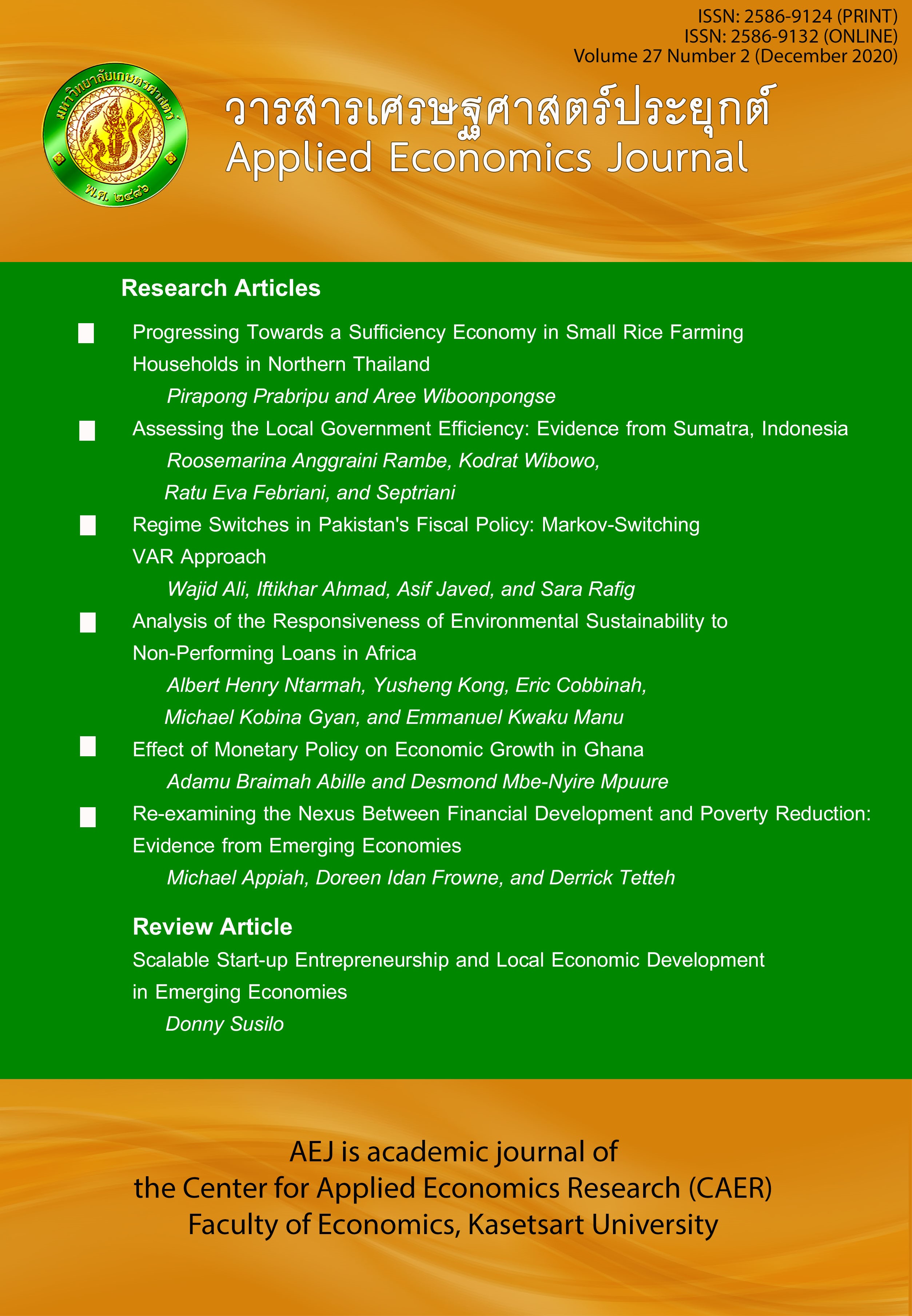Assessing the Local Government Efficiency: Evidence from Sumatra, Indonesia
Main Article Content
Abstract
The purposes of this research were to assess the relative efficiency of local government spending in Sumatra, Indonesia and to analyze the determinants of this efficiency. Data Envelopment Analysis (DEA) and multiple regression were employed for a data set of the spending of 154 local governments in 2016. Three inputs were used to measure the relative efficiency: (i) direct personnel spending per capita, (ii) spending on goods and services per capita, and (iii) capital spending per capita. The two outputs applied were life expectancy and years of schooling. The results show that, of the 154 local governments, 16, across eight provinces in Sumatra, were relatively efficient. Furthermore, population density and per capita gross regional domestic product significantly and positively affected local government efficiency. However, the general purposes grant per capita did not affect local government efficiency. Regional expansion did not cause the new split-region governments to be more relatively efficient than the governments of their parent regions.
Article Details
The paper is published under CC BY-NC-ND, in which the article is freely downloaded and shared in its original form non-commercially and its citation details are identified.
References
Adam, A., Delis, M., & Kammas, P. (2011). Public sector efficiency: Leveling the playing field between OECD countries. Public Choice, 146(1-2), 163-183.
Afonso, A., & Aubyn, M.S.T. (2005). Non-parametric approaches to education and health efficiency in OECD countries. Journal of Applied Economics, 8(2), 227-246.
Afonso, A., & Fernandes, S. (2008). Assessing and explaining the relative efficiency of local government. The Journal of Socio-Economics, 37(5), 1946-1979.
Agasisti, T. (2014). The efficiency of public spending on education: An empirical comparison of EU countries. Journal of Education, 49(4), 543-557.
Balaguer-Coll, M.T., & Prior, D. (2009). Short and long term evaluation of efficiency and quality: An application to Spanish municipalities. Applied Economics, 41(23), 2991-3002.
Boetti, L., Piacenza, M., & Turati, G. (2012). Decentralization and local governments’ performance: How does fiscal autonomy affect spending efficiency? Public Finance Analysis, 68(3), 269-302.
Bogetoft, P., & Otto, L. (2011). Benchmarking with DEA, SFA, and R. New York: Springer.
Booth, A. (2011). Splitting, splitting, and splitting again. A brief history of the development of regional government in Indonesia since independence. Bijdragen Tot De Taal-, Land- En Volkenkun, 167(1), 31-59.
Coelli, T.J., Rao, D.S.P., O’Donnell, C.J., & Battese, G.E. (2005). An introduction to efficiency and productivity analysis (2nd ed.). New York: Springer.
Cooper, W.W., Seiford, L.M., & Tone, K. (2002). Data Envelopment Analysis: A comprehensive text with models, applications, references, and DEA solver software. New York: Kluwer Academic Publishers.
Davis, M.L., & Hayes, K. (1993). The demand for good government. The Review of Economics and Statistics, 75(1), 148-152.
Deng, Z., Zhang, J., Feng, Y., & Wang, J. (2013). Factors influencing the supply efficiency of basic public service at county level. Asian Agricultural Research, 5(9), 53-59.
De Oliveira, F.G. (2012). Empirical determinants of government efficiency: A study based on objective indicators. Brazilian Political Science Review, 6(1), 53-69.
Dufrechou, P.A. (2016). The efficiency of public education spending in Latin America: A comparison to high-income countries. International Journal of Educational Development, 49, 188-203.
Fitrani, F., Hotman, B., & Kaiser, K. (2005). Unity in diversity? The creation of new local governments in a decentralising Indonesia. Bulletin of Indonesia Economic Studies, 5(1), 57-79.
Geys, B., & Moesen, W. (2009). Measuring local government technical (in)efficiency. An application and comparison of FDH, DEA, and econometric approaches. Public Performance & Management Review, 32(4), 499-513.
González, E., Cárcaba, A., & Ventura, J. (2010). Value efficiency analysis of health systems: Does public financing play a role? Journal of Public Health, 18(4), 337-350.
Gupta, S., & Verhoeven, M. (2001). The efficiency of government expenditure: Experiences from Africa. Journal of Policy Modeling, 23(4), 433-467.
Herrera, S., & Pang, G. (2005). The efficiency of public spending in developing countries: An efficiency frontier approach (World Bank Policy Research Working Paper Series No. 3645). Washington, DC: World Bank Group.
Hsu, M., Luo, X., & Chao, G.H. (2008). The fog of OECD and non-OECD country efficiency: A data envelopment analysis approach. The Journal of Developing Areas, 42(1 Fall), 81-93.
Hsu, Y. (2014). Efficiency in government health spending: A super slacks-based model. Quality & Quantity, 48(1), 111-126.
Huguenin, J-M. (2012). Data Envelopment Analysis (DEA): A pedagogical guide for decision-makers in the public sector. Lausanne: IDHEAP.
Mabuchi, M. (2001). Municipal amalgamation in Japan (World Bank Institute No. 37175). Washington, DC: The World Bank.
Moisio, A., & Uusitalo, R. (2013). The impact of municipal mergers on local public expenditures in Finland. Public Finance and Management, 13(3), 148-166.
Nannyonjo, J., & Okot, N. (2013). Local government capacity and efficiency of health service delivery in Uganda. Journal of African Development, 15(1), 125-158.
Pepinsky, T.B., & Wihardja, M.M. (2011). Decentralization and economic performance in Indonesia. Journal of East Asian Studies, Sep-Dec, 337-371.
Porcelli, F. (2014). Electoral accountability and local government efficiency: Quasi-experimental evidence from the Italian health care sector reforms. Economics of Governance, 15(3), 221-251.
Ray, S.C. (2004). Data envelopment analysis: Theory and techniques for economics and operations research. Cambridge: Cambridge University Press.
Rayp, G., & Sijpe, N.V.D. (2007). Measuring and explaining government efficiency in developing countries. Journal of Development Studies, 43(2), 360-381.
Sinimole, K.R. (2012). Evaluation of the efficiency of national health systems of the members of World Health Organization. Leadership in Health Services, 25(2), 139-150.
Slack, E., & Bird, R. (2013). Does municipal amalgamation strengthen the financial viability of local government? A Canadian example (ICEPP Working Papers No. 36). Atlanta, GA: International Center for Public Policy.
Yusfany, A. (2015). The efficiency of local governments and its influence factors. International Journal of Scientific & Technology Research, 4(10), 219-241.
Zhang, T., & Garvey, E. (2008). A comparative analysis of multi-output frontier models. Journal of Zhejiang University Science A, 9(10), 1426-1436.


